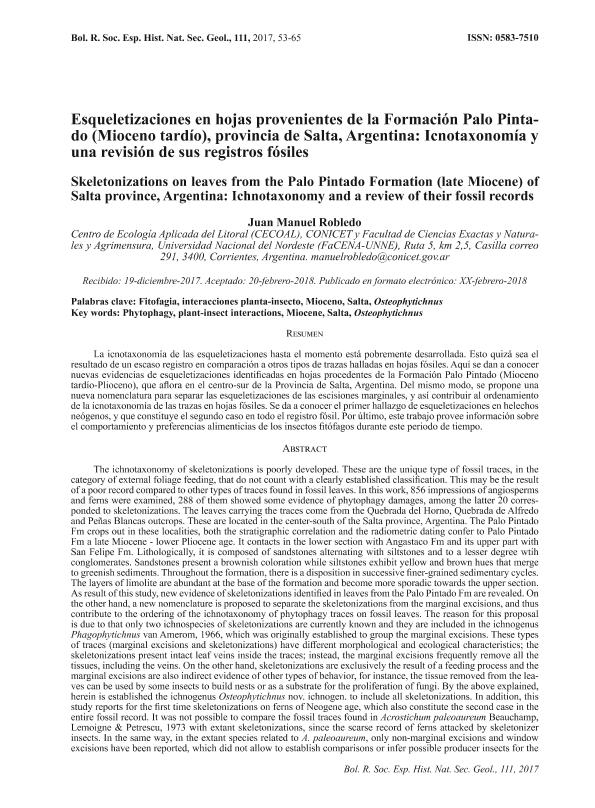Mostrar el registro sencillo del ítem
dc.contributor.author
Robledo, Juan Manuel

dc.date.available
2021-01-20T13:35:05Z
dc.date.issued
2017-12
dc.identifier.citation
Robledo, Juan Manuel; Esqueletizaciones en hojas provenientes de la Formación Palo Pintado (Mioceno tardío), provincia de Salta, Argentina: Icnotaxonomía y una revisión de sus registros fósiles; Real Sociedad Española de Historia Natural; Boletín de la Real Sociedad Española de Historia Natural; 111; 12-2017; 53-65
dc.identifier.issn
0583-7510
dc.identifier.uri
http://hdl.handle.net/11336/123151
dc.description.abstract
The ichnotaxonomy of skeletonizations is poorly developed. These are the unique type of fossil traces, in the category of external foliage feeding, that do not count with a clearly established classification. This may be the result of a poor record compared to other types of traces found in fossil leaves. In this work, 856 impressions of angiosperms and ferns were examined, 288 of them showed some evidence of phytophagy damages, among the latter 20 corresponded to skeletonizations. The leaves carrying the traces come from the Quebrada del Horno, Quebrada de Alfredo and Peñas Blancas outcrops. These are located in the center-south of the Province of Salta, Argentina. The Palo Pintado Fm crops out in these localities, both the stratigraphic correlation and the radiometric dating confer to Palo Pintado Fm a late Miocene - lower Pliocene age. It contacts in the lower section with Angastaco Fm and its upper part with San Felipe Fm. Lithologically it is composed of sandstones alternating with siltstones and to a lesser degree wtih conglomerates. Sandstones present a brownish coloration while siltstones exhibit yellow and brown hues that mergeto greenish sediments. Throughout the formation there is a disposition in successive finer-grained sedimentary cycles. The layers of limolite are abundant at the base of the formation and become more sporadic towards the upper section. As result of this study, new evidences of skeletonizations identified in leaves from the Palo Pintado Fm are revealed. On the other hand, a new nomenclature is proposed to separate the skeletonizations from the marginal excisions, and thus contribute to the ordering of the ichnotaxonomy of phytophagy traces in fossil leaves. The reason for this proposal is due to that only two ichnospecies of skeletonizations are currently known and they are included in the ichnogenus Phagophytichnus van Amerom, 1966, which was originally established to group the marginal excisions. These types of traces (marginal excisions and skeletonizations) have different morphological and ecological characteristics; the skeletonizations present intact leaf veins inside the traces; instead, the marginal excisions frequently remove all the tissues, including the veins. On the other hand, skeletonizations are exclusively the result of a feeding process and the marginal excisions are also indirect evidence of other types of behavior, for instance, the tissue removed from the leaves can be used by some insects to build nests or as a substrate for the proliferation of fungi. By the above explained, herein is established the ichnogenus Osteophytichnus nov. ichnogen. to include all skeletonizations. In addition, this study reports for the first time skeletonizations on ferns of Neogene age, which also constitute the second case in the entire fossil record. It was not possible to compare the fossil traces found in Acrostichum paleoaureum Beauchamp, Lemoigne & Petrescu, 1973 with extant skeletonizations, since the scarse record of ferns attacked by skeletonizer insects. In the same way, in the extant species related to A. paleoaureum, only non-marginal excisions and window excisions have been reported, which did not allow to establish comparisons or infer possible producer insects for thetraces reported in this work. Finally, herein is provided information about the behavior and food preferences of insectsduring the Neogene of South America.
dc.format
application/pdf
dc.language.iso
spa
dc.publisher
Real Sociedad Española de Historia Natural
dc.rights
info:eu-repo/semantics/openAccess
dc.rights.uri
https://creativecommons.org/licenses/by-nc-sa/2.5/ar/
dc.subject
Fitogagia
dc.subject
Interacciones Planta-Insecto
dc.subject
Mioceno
dc.subject
Salta
dc.subject.classification
Paleontología

dc.subject.classification
Ciencias de la Tierra y relacionadas con el Medio Ambiente

dc.subject.classification
CIENCIAS NATURALES Y EXACTAS

dc.title
Esqueletizaciones en hojas provenientes de la Formación Palo Pintado (Mioceno tardío), provincia de Salta, Argentina: Icnotaxonomía y una revisión de sus registros fósiles
dc.title
Skeletonizations on leaves from the Palo Pintado Formation (late Miocene) of Salta province, Argentina: Ichnotaxonomy and a review of their fossil records
dc.type
info:eu-repo/semantics/article
dc.type
info:ar-repo/semantics/artículo
dc.type
info:eu-repo/semantics/publishedVersion
dc.date.updated
2019-08-27T19:10:56Z
dc.journal.number
111
dc.journal.pagination
53-65
dc.journal.pais
España

dc.description.fil
Fil: Robledo, Juan Manuel. Consejo Nacional de Investigaciones Científicas y Técnicas. Centro Científico Tecnológico Conicet - Nordeste. Centro de Ecología Aplicada del Litoral. Universidad Nacional del Nordeste. Centro de Ecología Aplicada del Litoral; Argentina
dc.journal.title
Boletín de la Real Sociedad Española de Historia Natural
dc.relation.alternativeid
info:eu-repo/semantics/altIdentifier/url/https://dialnet.unirioja.es/servlet/articulo?codigo=6868071
dc.relation.alternativeid
info:eu-repo/semantics/altIdentifier/url/http://www.rsehn.es/index.php?d=publicaciones&num=67&w=402
Archivos asociados
